Conosciamo la sensazione. Quel momento di sconforto in cui il vostro sito va giù e non avete idea del perché. È uno degli errori più comuni di WordPress, ma anche uno dei più misteriosi. Non vi dice cosa c’è che non va, ma solo che qualcosa è rotto.
La buona notizia? È quasi sempre risolvibile. Avendo aiutato innumerevoli personalizzati, abbiamo avuto a che fare con questo errore molto spesso.
In questa guida vi illustreremo i passaggi esatti per ripristinare il vostro sito e renderlo funzionante. Seguiteci e vedrete che tutto tornerà a funzionare in pochissimo tempo.
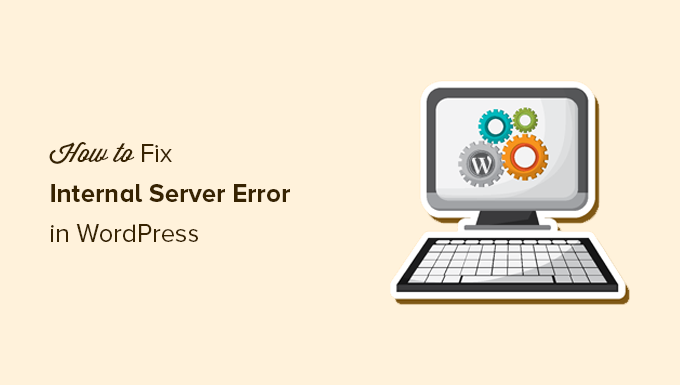
Ecco una rapida panoramica degli argomenti che tratteremo in questo articolo:
- What Is the 500 Internal Server Error?
- What Causes the Internal Server Error in WordPress?
- Fixing the 500 Internal Server Error in WordPress
- Clear WordPress and Browser Cache
- Checking for Corrupt .htaccess File
- Increasing the PHP Memory Limit
- Deactivate All WordPress Plugins
- Switch to a Default WordPress Theme
- Re-Uploading Core Files
- Enable Debug Logs in WordPress
- Ask Your Hosting Provider
- Video Tutorial
Che cos’è l’errore 500 Internal Server?
L’errore 500 Internal Server è come una porta bloccata senza chiave. Si sa che qualcosa non va, ma non c’è una nota che spieghi cosa è successo.
Questo errore non riguarda solo WordPress. Può apparire su qualsiasi sito web quando il server incontra un problema che non sa come gestire.
Il “500” nel messaggio è un codice di stato HTTP. Se lo cercate, troverete una definizione vaga:
“Il codice di risposta 500 Internal Server Error indica che il server ha incontrato una condizione inaspettata che gli ha impedito di soddisfare la richiesta”.
Non è molto utile, vero? È il modo in cui il server dice: “Si è rotto qualcosa, ma non sono sicuro di cosa”.
L’aspetto di questo errore dipende dalla configurazione dell’host e dal browser. Ecco un esempio di come appare su un server Apache:
Se il sito viene eseguito su Nginx, l’aspetto potrebbe essere leggermente diverso. Se Google Chrome non riesce a caricare una pagina di errore corretta, si vedrà qualcosa di simile:
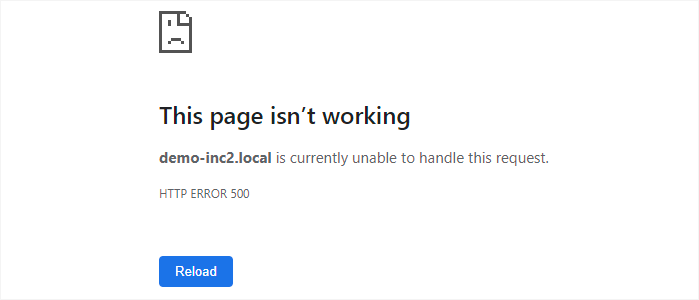
Per i principianti, questa situazione può risultare sconvolgente. Non c’è alcun messaggio che indichi cosa è andato storto o come correggerlo.
È come chiedere a un meccanico di correggere la vostra auto senza dirgli cosa è rotto. Dovranno controllare diverse parti fino a trovare il problema.
In base alla nostra esperienza, il modo migliore per correggere il problema è procedere passo dopo passo. Vi illustreremo le cause e le soluzioni più comuni per far sì che il vostro sito torni a funzionare.
Ottenete l’aiuto di un esperto in qualsiasi momento con il supporto WordPress on-demand!
Affrontare un errore interno del server può essere frustrante. Il nostro Supporto WordPress On-Demand è qui per aiutarvi a correggere i problemi tecnici in modo rapido ed efficace.
- Pagamento unico per l’assistenza on-demand di un esperto
- Tempi di consegna rapidi
- Disponibile 24 ore su 24, 7 giorni su 7
👉 O ttenete subito un supporto di emergenza per WordPress! 🛠️
Cosa causa l’errore interno del server in WordPress?
L’errore interno del server in WordPress è come un puzzle con pezzi mancanti. Sapete che qualcosa non va, ma il messaggio di errore non vi dice esattamente dove si trova il problema.
In base alla nostra esperienza, il colpevole più comune è un file .htaccess corrotto. A volte, si tratta di un plugin che si comporta male o di un tema che non funziona bene con la vostra configurazione.
Altre volte, il sito può colpire il limite di memoria PHP, causando il blocco di WordPress. Anche i file del core corrotti possono innescare questo errore, lasciandovi bloccati senza attenzione.
In alcuni casi, l’errore appare solo quando si cerca di accedere all’area di amministrazione di WordPress, mentre il resto del sito funziona correttamente. È come essere bloccati in casa propria mentre gli ospiti possono ancora entrare dalla porta sul retro.
Ciò che rende questo errore complicato è che di solito si verifica prima che WordPress possa essere caricato correttamente. Ciò significa che il server non può raccogliere abbastanza dettagli per spiegare cosa è andato storto.
Se volete dare un’occhiata più approfondita al funzionamento di WordPress dietro le quinte, consultate la nostra guida su come WordPress opera sotto il cofano.
Passiamo ora alla risoluzione dei problemi per ripristinare il funzionamento del sito.
Risolvere l’errore 500 Internal Server in WordPress
Prima di iniziare la risoluzione dei problemi, assicuratevi di avere a portata di mano un backup completo di WordPress del vostro sito web.
Se avete accesso all’area di amministrazione di WordPress, potete utilizzare un plugin di backup per WordPress per creare un backup completo del vostro sito web.
Per questo consigliamo di utilizzare Duplicator. Non solo vi aiuta a eseguire rapidamente il backup del vostro sito web, ma potete anche archiviare i vostri backup sul cloud e, soprattutto, potete ripristinare il vostro sito web dal backup.
D’altra parte, se non avete accesso all’area di amministrazione di WordPress, potete creare manualmente un backup di WordPress utilizzando phpMyAdmin e un client FTP.
In seguito, potete seguire i seguenti passaggi per risolvere il problema e risolvere l’errore del server interno sul vostro sito web.
Cancellare la cache di WordPress e del browser
I browser e i plugin di caching di WordPress possono talvolta memorizzare erroneamente una copia in cache di una pagina di errore.
Il modo più semplice per risolvere il problema è cancellare la cache del browser.
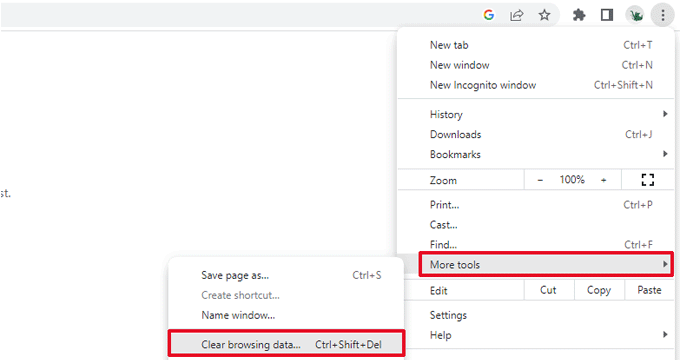
Dopodiché, se avete accesso all’area di amministrazione di WordPress del vostro sito web, potete svuotare la cache di WordPress visitando la pagina delle impostazioni del vostro plugin di caching.
Per maggiori dettagli, consultate il nostro tutorial su come cancellare la cache di WordPress.
Verifica della presenza di un file .htaccess corrotto
Il file .htaccess è un file di configurazione del server utilizzato da WordPress per impostare i reindirizzamenti.
Una delle cause più comuni di errore interno del server è il file .htaccess corrotto.
Il modo più semplice per correggere questo problema è semplicemente visitare la pagina Impostazioni ” Permalinks nell’area di amministrazione di WordPress e poi fare clic sul pulsante “Salva modifiche” senza apportare alcun cambiamento.
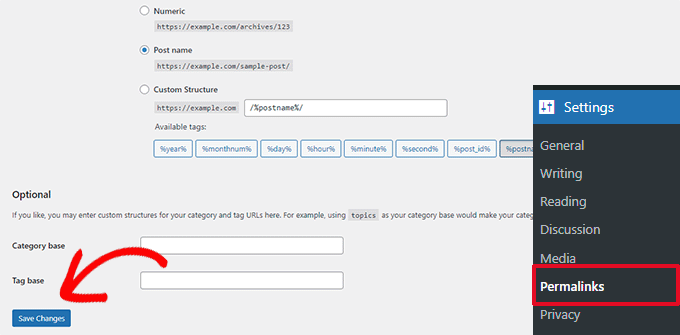
WordPress cercherà ora di aggiornare il file .htaccess o di generarne uno nuovo. Ora è possibile visitare il sito web per verificare se l’errore del server interno è stato corretto.
Se l’errore è ancora visibile, è necessario assicurarsi che WordPress sia stato in grado di generare o scrivere sul file .htaccess.
A volte, a causa delle autorizzazioni di file e directory, WordPress potrebbe non essere in grado di creare o scrivere sul file .htaccess.
Ora potete provare a sostituire il file .htaccess manualmente. Per prima cosa, dovete accedere al vostro sito web utilizzando l’FTP o l’applicazione File Manager nel pannello di controllo del vostro account di hosting.
Successivamente, è necessario rinominare ilfile .htaccess principale in qualcosa come .htaccess_old. Questo vi consente di mantenere il file come backup, ma WordPress non lo riconoscerà.
Per rinominare il file .htaccess, dovrete accedere al vostro sito utilizzando l’FTP o l’applicazione File Manager nel cruscotto del vostro account di hosting.
Una volta collegati, il file .htaccess si troverà nella stessa directory in cui sono presenti cartelle come wp-content, wp-admin e wp-includes.
È sufficiente fare clic con il tasto destro del mouse sul file .htaccess e rinominarlo in .htaccess_old.
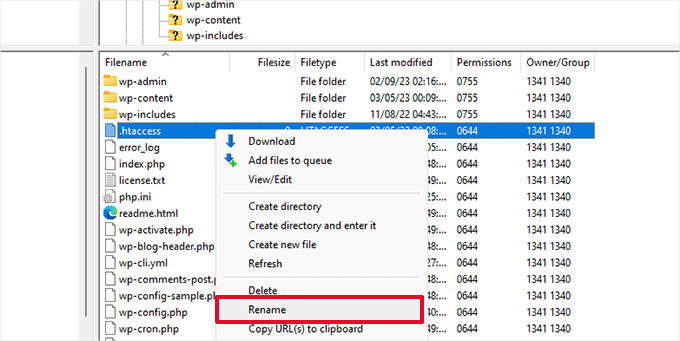
Successivamente, è necessario creare un nuovo file .htaccess.
All’interno della cartella principale del sito, fare clic con il tasto destro del mouse e selezionare l’opzione “Crea nuovo file” nel client FTP o nell’applicazione File Manager.
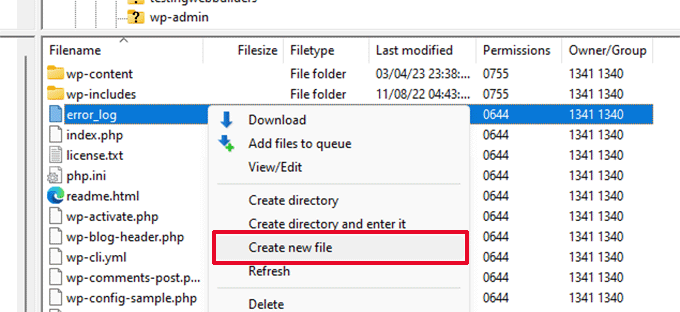
Nominate questo nuovo file .htaccess e fate clic su “OK” per salvarlo.
Ora, questo file .htaccess è attualmente vuoto ed è necessario aggiungervi le regole di riscrittura predefinite di WordPress.
È sufficiente fare clic con il tasto destro del mouse sul file e selezionare “Visualizza/Modifica” nel client FTP o nell’applicazione File Manager.
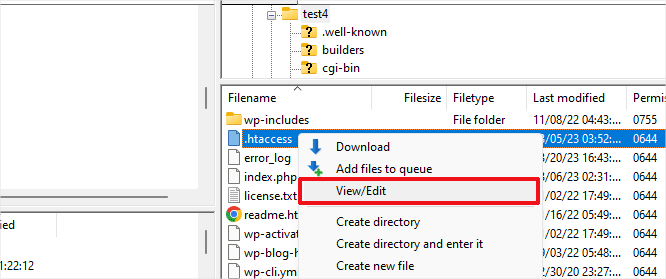
Il file vuoto si aprirà in un editor di testo semplice come Notepad o TextEdit.
A questo punto, è necessario copiare e incollare il seguente codice al suo interno:
1 2 3 4 5 6 7 8 9 10 | # BEGIN WordPress<IfModule mod_rewrite.c>RewriteEngine OnRewriteBase /RewriteRule ^index.php$ - [L]RewriteCond %{REQUEST_FILENAME} !-fRewriteCond %{REQUEST_FILENAME} !-dRewriteRule . /index.php [L]</IfModule># END WordPress |
Questo codice è il set di regole predefinito utilizzato da WordPress. Non dimenticate di salvare le modifiche e di caricare il file sul server.
Ora è possibile visitare il sito web per verificare se l’errore del server interno è stato risolto.
In caso affermativo, allora datevi una pacca sulla spalla perché avete risolto l’errore interno del server.
Importante: prima di procedere con altre operazioni, assicuratevi di andare alla pagina Impostazioni ” Permalinks nell ‘area di amministrazione di WordPress e di fare clic sul pulsante Salva senza apportare alcuna modifica. In questo modo il file .htaccess verrà rigenerato con regole di riscrittura adeguate per garantire che le pagine dei vostri post non restituiscano un errore 404.
Se la soluzione per verificare la presenza di un file .htaccess corrotto non ha funzionato, allora dovete continuare a leggere questo articolo.
Aumentare il limite di memoria di PHP
A volte, l’errore interno del server può verificarsi se uno script consuma tutto il limite di memoria di PHP.
Il modo più semplice per aumentare il limite di memoria di PHP è modificare il file wp-config.php. Se siete principianti, fate attenzione a questa operazione. Seguite attentamente queste istruzioni, perché anche piccoli errori nei file principali di WordPress possono danneggiare il vostro sito.
Per iniziare, è sufficiente collegarsi al proprio sito web WordPress utilizzando un client FTP o l’applicazione File Manager nel pannello di controllo del proprio account di hosting.
Il file wp-config.php si trova nella cartella principale del vostro sito web. Fate clic con il tasto destro del mouse su di esso e selezionate “Scarica”. In questo modo vi assicurerete di avere un file di backup nel caso in cui qualcosa vada storto.
Una volta salvato, è possibile fare clic con il pulsante destro del mouse e selezionare “Visualizza/Modifica”.
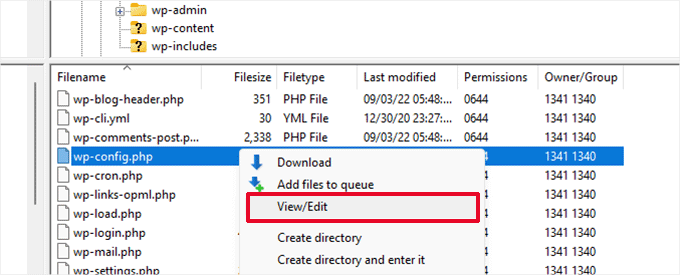
All’interno del file wp-config.php, è necessario aggiungere il seguente codice appena sopra la riga che recita: “Questo è tutto, smettete di modificare! Buona pubblicazione”:
1 | define( 'WP_MEMORY_LIMIT', '256M' ); |
Per maggiori dettagli, consultate il nostro tutorial su come aumentare il limite di memoria PHP in WordPress.
Nota: se 256M non risolve il problema, provare ad aumentare a 512M.
Se l’errore del server interno viene visualizzato solo quando si tenta di accedere all’amministrazione di WordPress o di caricare un’immagine in wp-admin, allora è necessario aumentare il limite di memoria seguendo questi passaggi:
- Creare un file di testo vuoto sul computer e chiamarlo php.ini.
- Incollare questo codice: memoria=256MB
- Salvare il file
- Caricate il file nella cartella /wp-admin/ tramite FTP.
Se l’aumento del limite di memoria ha risolto il problema, allora il problema è stato risolto solo temporaneamente. È ancora necessario trovare la causa che sta esaurendo il limite di memoria.
Potrebbe trattarsi di un plugin mal codificato o anche di una funzione del tema. Vi consigliamo vivamente di chiedere alla vostra società di web hosting WordPress di esaminare i log del server per aiutarvi a trovare la diagnostica esatta.
Se l’aumento del limite di memoria di PHP non ha corretto il problema, è necessario risolvere altri problemi.
Disattivare tutti i plugin di WordPress
Se nessuna delle soluzioni precedenti ha funzionato, è molto probabile che l’errore sia causato da un plugin specifico installato sul vostro sito web.
È anche possibile che si tratti di una combinazione di plugin che non funzionano bene tra loro.
Se potete accedere all’area di amministrazione di WordPress del vostro sito web, potete semplicemente andare alla pagina dei plugin e disattivare tutti i plugin di WordPress.
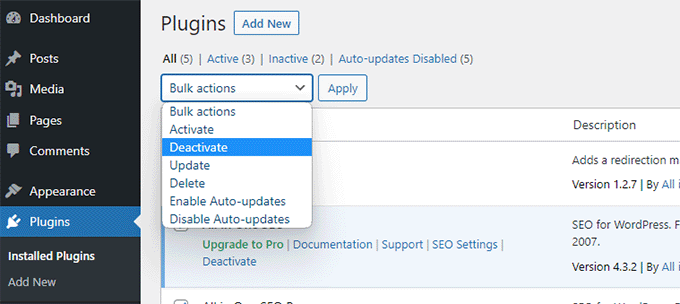
Tuttavia, se non riuscite ad accedere all’area di amministrazione di WordPress, potete disattivare tutti i plugin di WordPress utilizzando l’FTP.
È sufficiente collegarsi al proprio sito Web WordPress utilizzando un client FTP o l’applicazione di gestione dei file nel pannello di controllo del proprio account di hosting.
Una volta collegati, navigare nella cartella /wp-content/ e rinominare la cartella plugins in plugins.deactivated.
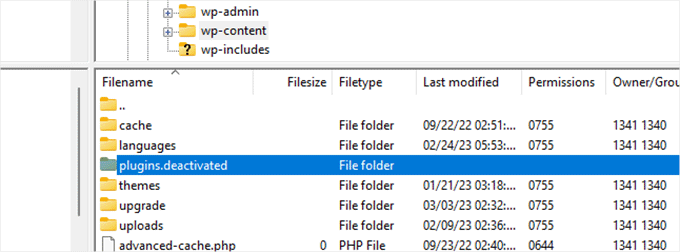
WordPress cerca i plugin nella cartella plugins. Se la cartella plugins non viene trovata, disattiverà automaticamente tutti i plugin.
Ora potete provare a visitare il vostro sito web per verificare se questo ha risolto l’errore del server interno sul vostro sito web.
Per ripristinare tutti i plugin, è sufficiente rinominare la cartella ‘plugins.deactivated’ in plugins.
I plugin verranno ripristinati, ma saranno ancora disattivati.
Ora è possibile attivare i singoli plugin e visitare il sito web per capire quale plugin sta causando l’errore interno del server.
Per maggiori dettagli, consultate la nostra guida su come disattivare tutti i plugin di WordPress senza wp-admin.
Se la disattivazione di tutti i plugin non ha risolto l’errore interno del server sul vostro sito web, continuate a leggere.
Passare a un tema WordPress predefinito
Una possibile causa dell’errore del server interno potrebbe essere un codice del tema di WordPress.
Per determinare se questo è il caso, è necessario cambiare il tema con un tema predefinito di WordPress.
Se avete accesso all’area di amministrazione di WordPress, andate alla pagina Aspetto ” Temi. Se è già installato un tema predefinito, è sufficiente fare clic sul pulsante Attiva per cambiare il tema.
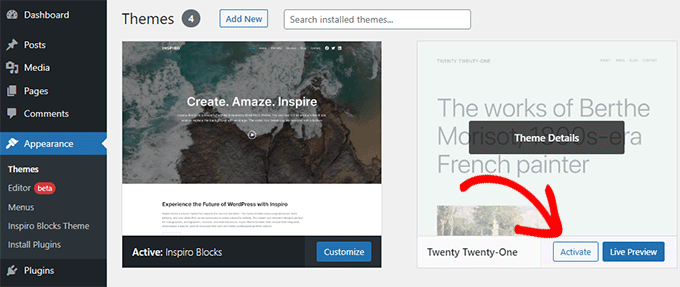
Se non avete installato un tema predefinito, potete fare clic sul pulsante “Aggiungi nuovo” in alto e installare un tema predefinito (Twenty Twenty-Three, Twenty Twenty-Two e così via).
Se non avete accesso all’area di amministrazione di WordPress, potete comunque passare a un tema predefinito.
È sufficiente collegarsi al proprio sito web WordPress utilizzando un client FTP e navigare nella cartella /wp-content/.
Fare clic con il pulsante destro del mouse per selezionare la cartella dei temi e scaricarla sul computer come backup.
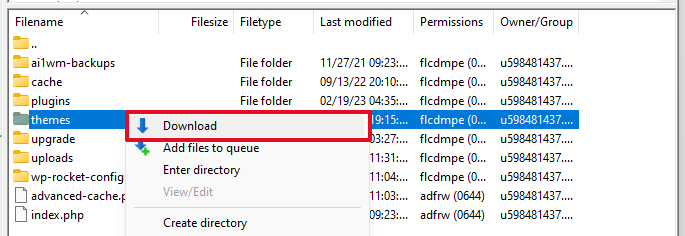
Successivamente, è necessario eliminare la cartella themes dal sito web. Una volta eliminata, creare una nuova cartella themes.
La nuova cartella dei temi sarà completamente vuota, il che significa che al momento non è stato installato alcun tema di WordPress.
Successivamente, è necessario visitare la directory dei temi di WordPress e scaricare un tema predefinito di WordPress sul computer.
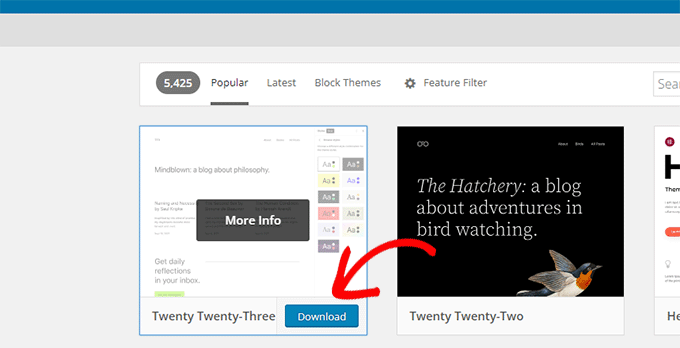
Il vostro browser scaricherà quindi il tema come file zip sul vostro computer.
Individuare il file sul computer e decomprimerlo. Gli utenti di Windows possono decomprimere il file facendo clic con il pulsante destro del mouse e selezionando “Estrai tutto”. Gli utenti Mac possono fare doppio clic sul file zip per estrarlo.
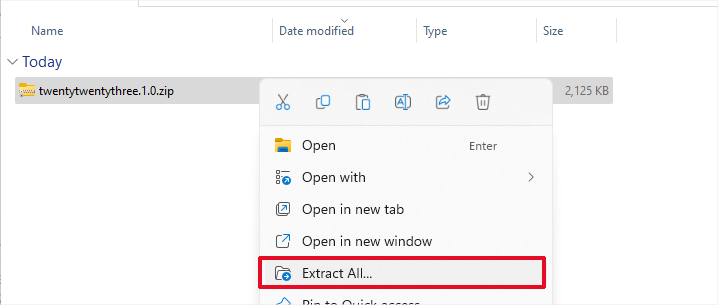
Ora vedrete una cartella contenente il vostro tema di WordPress.
Passare nuovamente al client FTP o al File Manager e caricare questa cartella nella cartella vuota dei temi.
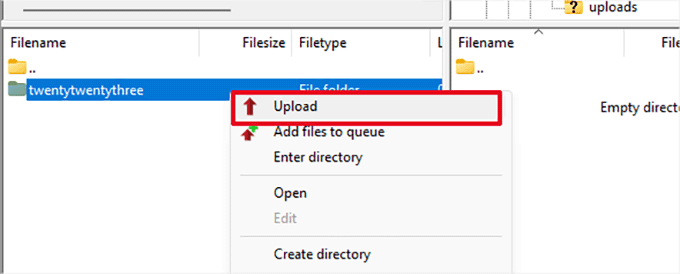
Una volta caricato, WordPress inizierà automaticamente a utilizzare il tema predefinito.
Ora è possibile visitare il sito web per verificare se l’errore del server interno è stato risolto.
Se non funziona, potete ricaricare i vostri temi WordPress dal backup o tornare al tema che stavate usando.
Non preoccupatevi. Ci sono ancora alcune cose che potete fare per risolvere l’errore.
Ricaricamento dei file del nucleo
Se le opzioni dei plugin e dei temi non hanno risolto l’errore interno del server, è opportuno ricaricare le cartelle /wp-admin/ e /wp-includes/ da una nuova installazione di WordPress.
Questa operazione NON rimuove le informazioni, ma può risolvere il problema nel caso in cui un file sia danneggiato.
Per prima cosa, è necessario visitare il sito web WordPress.org e fare clic sul pulsante “Download”.
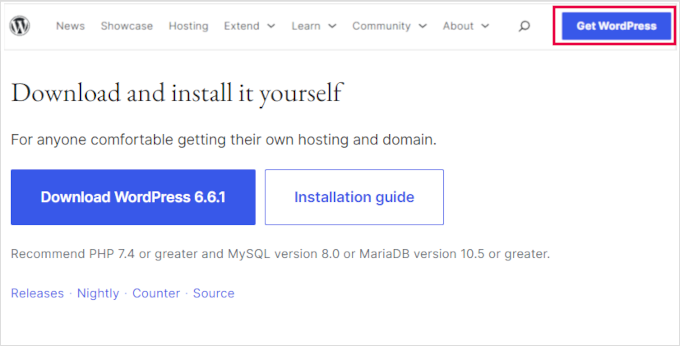
Questo scaricherà il file zip di WordPress sul vostro computer.
Procedere con l’estrazione del file zip. Al suo interno troverete una cartella wordpress.

Successivamente, è necessario collegarsi al proprio sito web WordPress utilizzando un client FTP.
Una volta collegati, accedere alla cartella principale del sito web. È la cartella che contiene le cartelle wp-admin, wp-includes e wp-content.
Nella colonna di sinistra, aprite la cartella WordPress sul vostro computer.
Ora è necessario selezionare tutti i file presenti nella cartella di wordpress e caricarli sul sito web.
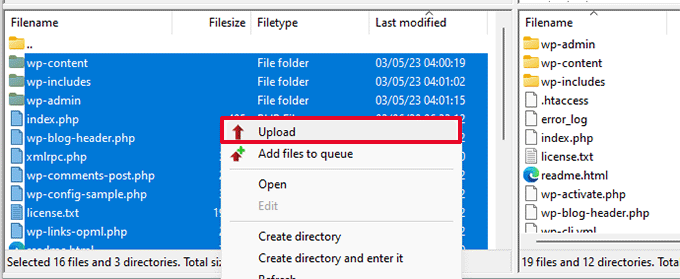
Il vostro client FTP trasferirà ora queste cartelle sul vostro server.
Verrà chiesto se si desidera sovrascrivere i file. Selezionare “Sovrascrivi”, quindi selezionare “Usa sempre questa azione” e selezionare la casella di controllo “Applica solo alla coda corrente”.
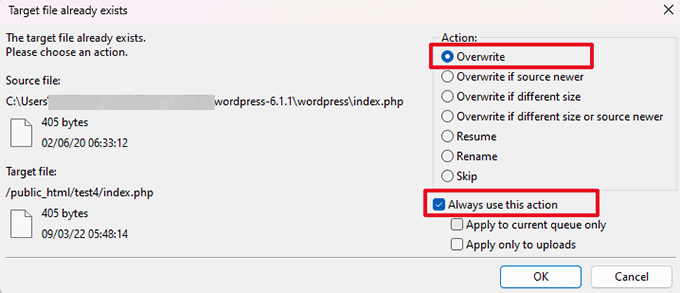
Il vostro client FTP sostituirà ora i vecchi file di WordPress con nuove copie fresche.
Se i file di WordPress sono stati danneggiati, questo passaggio risolverà l’errore interno del server.
Abilitare i log di debug in WordPress
WordPress è dotato di un sistema integrato per mantenere i log per il debug.
È possibile attivarlo utilizzando il plugin WP Debugging. Per maggiori dettagli, consultate la nostra guida su come installare un plugin di WordPress.
Una volta attivato, il plugin attiva i log di debug sul vostro sito web WordPress.
Se non avete accesso all’area di amministrazione del vostro sito WordPress, potete attivare il debug aggiungendo il seguente codice al file wp-config.php:
1 2 | define( 'WP_DEBUG', true);define( 'WP_DEBUG_LOG', true); |
Una volta attivati i log di debug, è possibile visualizzarli utilizzando un client FTP e navigando alla cartella /wp-content/.
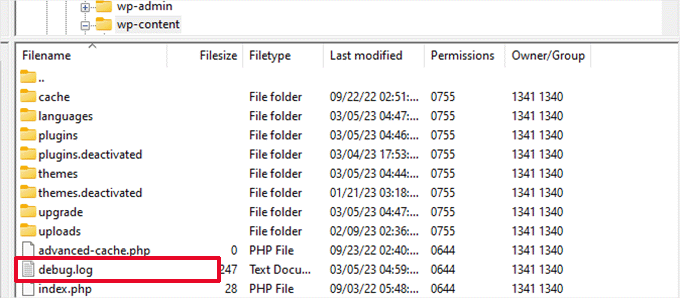
Il file di log di debug può essere aperto in un editor di testo e mostrerà un elenco di errori e avvisi che si verificano sul sito web.
Alcuni errori e avvisi possono essere incidenti innocui che non devono essere risolti. Tuttavia, se il vostro sito web presenta un errore interno del server, questi possono indicarvi la giusta direzione.
Chiedete al vostro fornitore di hosting
Se tutti i metodi non riescono a risolvere l’errore interno del server sul vostro sito web, allora è il momento di chiedere aiuto.
Contattare il team di assistenza del web hosting, che sarà in grado di controllare i registri del server e individuare la causa principale dell’errore.
Se volete continuare a risolvere i problemi da soli, consultate la nostra guida definitiva alla risoluzione dei problemi di WordPress per i principianti.
Video tutorial
Se questo articolo vi è piaciuto, iscrivetevi al nostro canale YouTube per le esercitazioni video su WordPress. Potete trovarci anche su Twitter e Facebook.





Eduard
Thank you!!! this worked for me too. It was the corrupt .htaccess File. Deleting this one and giving a new one to my clients webfolder helped and prevented me from a new install (I thought of it in my despare)
have a good time you all
eduard
ulrich
The .htaccess file trick did it for me. Thanx
Christiaan Neijens
We changed hosting and ran into the internal server error, luckely renaming the htaccess file worked perfectly.
Thank you!
Martin
Hello there … that internal server error is a strong problem since 10 days I deactivated all plugins – so the wordpress installation worked again – BUT after activating ONE plugin (no matter which one) the error came back … can anyone give me advice?
I deactivated all plugins – so the wordpress installation worked again – BUT after activating ONE plugin (no matter which one) the error came back … can anyone give me advice?
WPBeginner Support
did you try switching back to default WordPress theme and then activating plugins? You can also try increasing memory size limit available to php.
If this does not solve the problem, then contact your web host.
Admin
jules
THANK YOU ! USED PHP.INI AND removed Jetpack!~ Shouting for joy as I learn I am not as old as I look !
Khym
Hello,
I tried to install a Child plugin in my WordPress site and after that I encountered an Internal Server Error. Problem is, I can’t locate the installed plugin in my wp-content folder. What I get is an error.txt file with the below details:
PHP Parse error: syntax error, unexpected T_STRING in /home3/kennelsf/public_html/bad-credit-solutions-now/wp-content/themes/uvctheme/functions.php on line 53
I don’t understand if this error is somehow connected to the plugin that I installed but why can’t I see the plugin on my folder?
I really, really appreciate your help!
Thanks!
Editorial Staff
Try looking at what code you have in that line of your functions.php file.
Admin
Georgie
Thank you thank you! Followed your instructions about the htaccess file and that solved not only my Error 500 problem trying to login to my admin panel but another problem I was having with thumbnail images not loading properly using Clockstone theme from CMSMasters.
Cheryl
Thank you so much. I followed your directions for the 500 server error and the .htaccess.The steps worked for after I updated the Permalinks, which took a few tries since the page was loading so slow and the error page kept coming back up. Now all is fine and I also increased the php memory.
Kulwinder Singh
Thanks U very much .
Roxy
Genius! Thank you. I was getting the 500 internal error when selecting menus and customise links inside the admin area, including when trying to live preview for other themes.
I tried all of the steps one by one, and the one that worked was replacing wp-admin and wp-includes from a fresh install of WordPress on my desktop.
Sorted it out completely! Many thanks indeed.
Now if anyone knows a good code for an accordion menu, that includes the page text in the drop down, please let me know!
Thanks
Roxy
Ellis
Thanks for a clear set of instructions. I worked through them and solved the problem. Great work.
Jahanzeb
Hey, changing the name of the htaccess is giving me 404 errors, and I cant access wp-admin to login, help!
Jahanzeb
Actually, every thing is fixed now, no more 404’s, just that I can’t login! Can anyone help me
Editorial Staff
Clear your cookies.
Admin
Sharad
Thanks a ton- disabling plugin worked for me
Srihari Thalla
Thanks
I forgot to update the Permalinks!!
Editorial Staff
Yup that’ll do it.
Admin
Nishant Shubham
I am too having a problem with this. It says :
Internal Server Error
The server encountered an internal error or misconfiguration and was unable to complete your request.
It happened after I installed a plugin Hide Login. I clecked on Activate and all this started happening. It happens when I try to log in admin panel. Please help me.
Jelle
Rename the folder of the plugin via FTP, that will deactivate it!
Kate
Thanks so much for the Tipps.
I couldn’t get into my Admin Panal. After a few hours I fured out, that somehow my permissions on the wp-login.php file got set to 00… I switched them back and my problem was solved.
Cassy
Thank you very much. The ht.access rename worked for me.
Kailas Kale
Thank u very much for helping me to solve my problem….
Oscar
I followed your tips 1(.httacess), 2(php.ini) and 4(core files) and the problem still is.
If i deactived the plugins, ill need to configurate them later? (i meant, if they were Reset?)
Tip 5, my hosting provider havent gave me any solution yet since long time.
Just to say my blog is on a share server, do i need to chance to a dedicated server or change my hosting provider?
Justin
Thanks Syed, I added something to my .htaccess file and I got the 500 internal message. Renaming the file in cpanel worked and fixed the problem.
Thanks so much, I bookmarked this page for future reference.
Chris
Thank you for this tutorial!
You saved me!!!
I solved it by deactivating the plugins.
Best regards,
Chris
Dan Terry
I backed up the .htaccess file then deleted it off the wordpress main directory then went to settings and permalinks and clicked saved and it fixed it!
Lani
Thank you so much! I was in a stress. This is the last straw for me trying to manage my wp.org site on my own, I’m upgrading to a premium theme so I don’t have this stuff to deal with (I hope). Cheers
Cfouche
I deactivated my plugins and it worked! Spent so much time trying to fix it by adding more php memory, but that was all i needed to do.
Thanks!
Kimmo
I got this same error message and solved it by changing the character encoding of wp-config.php from UTF to ANSI.
Goran
Thanks, mate. The increased memory size fixed the problem. Now Google can index the website again!
Maciej
Thanks!
I only changed name of Htaccess file and that works!
andy
Nice article even I cannot find any solutions for Internal Server Error, but it really help me and enrich my WP knowledge. Thanks again!
Olatubosun
Thanks for the tip. It totally solved the problem I had at my blog.
Thanks again!!!
William Watt
Thank you!
Tadrash Shah
.htaccess was corrupted. I deleted it from my hosting FTP account and things were set to normal.
thanks a ton.
Diana
this worked for me as well!! Thank you so much!!
MundaneStudies
This didn’t fix the problem but it was extremely helpful & gave me a strategy, instead of spending hours reading forum posts that were all over the map. Thanks!
Ruth
I had this problem but it was my pages and posts that wouldn’t show and wp-admin and home were both fine.
I tried everything suggested here to no avail. My host suggested checking my error logs in cPanel and there I found it was one of the pages of my theme, single.php, was spitting out an error.
If you have a similar problem where the admin panel is fine – switch to another theme. If that fixes it you’ll need to either reupload your theme or check your error logs to see which file is causing the problem and just reupload that one.
Hope that helps someone!
Hikmat
Thanks you saved my day…..
Anton DeSiva
Thanks buddy, you really helped me out on this one. Looks like my access file got screwed up (I reckon I know the plugin that caused it too). Once again, thanks!!
marko
A really BIG THANK YOU I could fix this problem with your Help!
Mahali
Thank you very much my problem is fix because your post, re-uploading core file is my answer
oifif
Right in the pain! Complete! Clear!
its just Perfect!
Thx for sharing, and allow me to share the info..
regards,
/oifif
zozo2001
I got the Corrupt htaccess file error and i fixed it by renaming the file and generate blank one. but the issue that i am getting this error every 2 – 3 days and i am doing the same treatment.
any help one this please?
Editorial Staff
Contact your host to see why your .htaccess is getting corrupt so frequently.
Admin
yogesh
a very big thanks from to you i fixed my site problem…
Ege
Hi there, good article just want to expand upon it by sharing what I just went through. So I was getting a 500 error in chrome and firefox was just displaying a blank page.
I added this code:
ini_set(‘display_errors’, ‘1’);
right in the second line of my index.php(after “<?") and it showed me that the actual error was happening because of
require('./wp-blog-header.php');
in my index.php file. Turns out that my host changed the way they handle the file system, and wordpress got burned because of it. Removing the './' before it solved my problem.
Hope this helps someone.
Editorial Staff
Thank you very much for sharing this valuable information Ege. We really appreciate it, and others will too.
Admin
Johanna
Thank for the error tip, it saved my life! This is THE best way to find the error and solve it.
Amms
only thiis works for me.
zozo2001
Excellent post, first solution worked great for me.
You saved my day.
Sofie
Hi there,
When I tried to go onto my site yesterday I got the Internal Server Error. I went to the support forum of my host and found how to access my error logs, but … the button to access them wasn’t working.
I did a database restore, which made the site work again, but today someone notified me the site had been down again. It seems to go on and off without me changing anything.
I’ve now finally managed to get into my error logs and it lists 4 weird names that end on ‘-error.log’ AND the .htaccess.
So I’m guessing that’s corrupt.
However, when I tried to rename the .htaccess I got an error message saying that that filename didn’t exist and so the old name remained.
Any idea on how I can work around this?
I’ve already contacted my host multiple times and while they’re saying they’re looking into it, I’m guessing they aren’t really…
Editorial Staff
Sounds like a corrupt .htaccess. Try using the FTP to upload a blank .htaccess file.
Admin
Sofie
And how do I do that?:)
Dan
Corrupt htaccess file after I tried to update an event calendar plug-in. I had it fixed in two minutes AFTER finding your article. Whew!!! Thanks for lowering my blood pressure!!!
Leah
thx SO much, i had a corrupted htaccess..i almost had a heart attack, thx for the info
Manveet Singh
I get this error when I hit ‘publish’ on a new post a few times now.
It looks like deactivating plugins would be the best way for me, right?
Luis
How many and what plugins do you use?
Rajandran R
For a dedicated server with a quite high traffic site what is the ideal settings for PHP memory limit
Does 64MB does good?
Editorial Staff
Best to ask your hosting provider because it depends on the dedicated server specs.
Admin
Patrice Albertus
Thanks for this article. Error 500 in a common issue on WP. Unfortunately for is no real solution (except maybe paying for an expensive dedicated server with 2048Mo memory…). The plugin solution seems also to be relevant.
Mukesh Kumar
I already tried doing the php.ini memory=20MB solution but it did not work. I uploaded it under the wp-admin/ folder.
I’m not really sure what else to try. Help?
Shikeb Ali
I have faced this problem quite a few times, and re uploading core WP file solved problem for me twice and once it was .htaccess file was corrupt.
Thanks for information about PHP memory increase.
Editorial Staff
Anytime man. We often create these articles as a reference for when we run into the problems in the future (specially for our new staff).
Admin
Luis
This sounds like a disk failure.